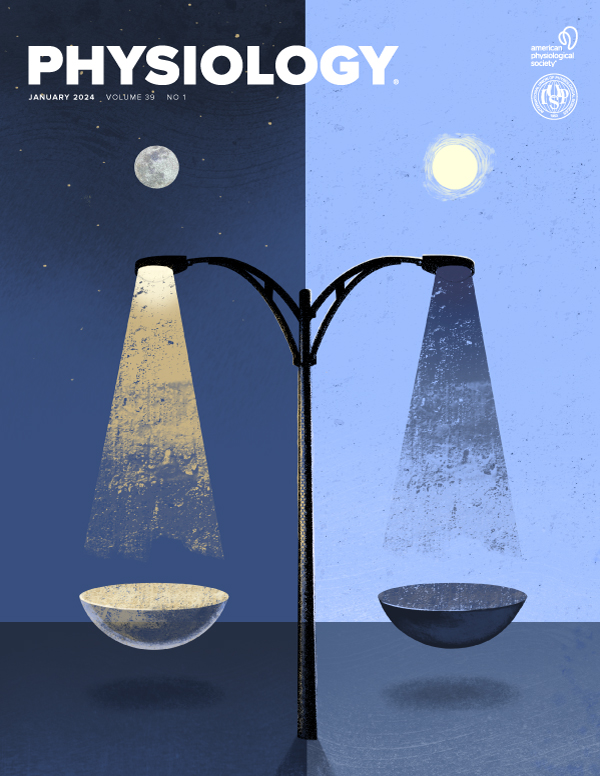在渐进式有节奏握力练习中,衰老对肌肉交感神经放电模式的性别特异性影响
IF 5.3
2区 医学
Q1 PHYSIOLOGY
引用次数: 0
摘要
在整个生命周期中,患高血压的风险存在性别差异,绝经后女性患高血压的比例高于同龄男性。虽然潜在的机制是多因素的,但过度的交感神经-心血管反应可能是一个重要的因素。事实上,与年轻人和老年男性相比,绝经后的女性表现出了夸张的运动压力反应。然而,在运动过程中,年龄和性别对肌肉交感神经活动(MSNA)和动作电位(AP)编码模式的交互影响尚不清楚。我们假设,与年轻男性和女性以及老年男性相比,老年女性在运动期间和运动后循环闭塞(PECO)期间的MSNA和AP招募增加最多。对12例年轻男性(YM (mean±SD))的MSNA和AP放电模式(微神经造影和连续小波变换)进行评估;26±4,岁),年轻女性11例(YF;25±4岁),老年男性11例(OM;71±11岁),老年女性12例(OF;(71±4年),增加有节奏的握力锻炼至疲劳,然后进行2分钟的PECO。在运动高峰时,与所有其他组相比,OM的MSNA突发发生率(BI)比基线(Δ)变化较小(YM: Δ8±9,YF: Δ9±8,OM: Δ-6±8,OF: Δ6±7次/100次心跳;方差分析均为事后P0.05)。相反,YM表现出更大的ΔAPs/burst (YM: Δ5±3,OM: Δ0.4±3,OF: Δ2±2 APs/burst;事后P<0.05)和ΔAP clusters/burst (YM: Δ2±1,OM: Δ0.1±1,OF: Δ0.7±0.7 clusters/burst;事后P<0.05),但与YF相比,P<0.05 (Δ2±3 APs/burst和Δ0.9±0.8 clusters/burst);两个P≥0.07)。然而,在较大轴突的募集方面,各组间无差异(YM: Δ6±2,YF: Δ4±2,OM: Δ2±5,of: Δ4±3;P = 0.33)。与运动相反,在PECO过程中,ΔMSNA BF (P<0.01)、ΔBI (P<0.01)和Δtotal活性(P<0.01)存在群体-时间相互作用,其中年轻人PECO的第一分钟比老年人增加更多(均事后P<0.05),而在PECO的最后一分钟,MSNA ΔBF和ΔBI仅在YM中比在OM和of中增加(均P<0.05),而在YM和YF中总活性仅比在of中增加(均P<0.05)。在PECO期间,未观察到ΔMSNA BA (P=0.37)、ΔAPs/burst (P=0.94)、ΔAP clusters/burst (P=0.95)或Δtotal AP clusters (P=0.41)之间按时间分组的相互作用。总的来说,运动时的MSNA和AP反应性在OF中没有被夸大,但在男性中观察到与年龄相关的AP招募减少。在PECO期间,相对于年轻人,老年人的MSNA反应较低,但AP招募未因年龄而改变。因此,过高的MSNA或AP反应性可能无法解释of中高血压的较高患病率。由加拿大自然科学与工程委员会和IEEM间接基金资助。这是在2023年美国生理学峰会上发表的完整摘要,仅以HTML格式提供。此摘要没有附加版本或附加内容。生理学没有参与同行评议过程。本文章由计算机程序翻译,如有差异,请以英文原文为准。
Sex-specific impact of aging on muscle sympathetic neural discharge patterns during incremental rhythmic handgrip exercise
Sex-disparities exist in the risk of developing hypertension throughout the lifespan, with a greater prevalence of hypertension amongst postmenopausal females compared to similarly aged males. Though the underlying mechanisms are multifactorial, exaggerated sympathetic neuro-cardiovascular reactivity may be an important contributor. Indeed, postmenopausal females exhibit exaggerated exercise pressor responses compared to young adults, and older males. However, the interactive effects of age and sex on muscle sympathetic nerve activity (MSNA) and action potential (AP) coding patterns during exercise remains unclear. We hypothesized that older females would exhibit the greatest increase in MSNA and AP recruitment during exercise and post-exercise circulatory occlusion (PECO) relative to young males and females, as well as older males. MSNA and AP discharge patterns (microneurography and continuous wavelet transform) were assessed in 12 young males (YM (mean±SD); 26±4, years), 11 young females (YF; 25±4 years), 11 older males (OM; 71±11 years), and 12 older females (OF; 71±4 years) during incremental rhythmic handgrip exercise to fatigue followed by 2 minutes of PECO. At peak exercise, OM demonstrated a smaller change from baseline (Δ) in MSNA burst incidence (BI) compared to all other groups (YM: Δ8±9, YF: Δ9±8, OM: Δ-6±8, OF: Δ6±7 bursts/100heartbeats; all ANOVA post-hoc P<0.05), whereas ΔMSNA burst frequency (BF), Δburst amplitude (BA), and Δtotal activity were not different between groups (all P>0.05). Conversely, YM demonstrated greater ΔAPs/burst (YM: Δ5±3, OM: Δ0.4±3, OF: Δ2±2 APs/burst; post-hoc P<0.05) and ΔAP clusters/burst (YM: Δ2±1, OM: Δ0.1±1, OF: Δ0.7±0.7 Clusters/burst; post-hoc P<0.05) compared to OM and OF, but not compared to YF (Δ2±3 APs/burst and Δ0.9±0.8 clusters/burst; both P≥0.07). However, no group differences were observed in the recruitment of larger axons (YM: Δ6±2, YF: Δ4±2, OM: Δ2±5, OF: Δ4±3 clusters; P=0.33). Contrary to exercise, group-by-time interactions existed during PECO for ΔMSNA BF ( P<0.01), ΔBI ( P<0.01), and Δtotal activity ( P<0.01) where greater increases occurred during the first minute of PECO in young compared to older adults (all post-hoc P<0.05), whereas in the final minute of PECO, MSNA ΔBF and ΔBI were only greater in YM compared to OM and OF (all P<0.05), and total activity was greater in YM and YF compared to OF only (all P<0.05). No group-by-time interactions were observed for ΔMSNA BA ( P=0.37), ΔAPs/burst ( P=0.94), ΔAP clusters/burst ( P=0.95) or Δtotal AP clusters ( P=0.41) during PECO. Altogether, MSNA and AP reactivity during exercise was not exaggerated in OF, but age-related reductions in AP recruitment were observed in males. During PECO, MSNA responses were lower in older relative to young adults but, AP recruitment was unaltered by age. Thus, exaggerated MSNA or AP reactivity may not explain the greater prevalence of hypertension in OF. Supported by the Natural Sciences and Engineering Council of Canada, and IEEM Indirect Funds. This is the full abstract presented at the American Physiology Summit 2023 meeting and is only available in HTML format. There are no additional versions or additional content available for this abstract. Physiology was not involved in the peer review process.
求助全文
通过发布文献求助,成功后即可免费获取论文全文。
去求助
来源期刊

Physiology
医学-生理学
CiteScore
14.50
自引率
0.00%
发文量
37
期刊介绍:
Physiology journal features meticulously crafted review articles penned by esteemed leaders in their respective fields. These articles undergo rigorous peer review and showcase the forefront of cutting-edge advances across various domains of physiology. Our Editorial Board, comprised of distinguished leaders in the broad spectrum of physiology, convenes annually to deliberate and recommend pioneering topics for review articles, as well as select the most suitable scientists to author these articles. Join us in exploring the forefront of physiological research and innovation.
 求助内容:
求助内容: 应助结果提醒方式:
应助结果提醒方式:


